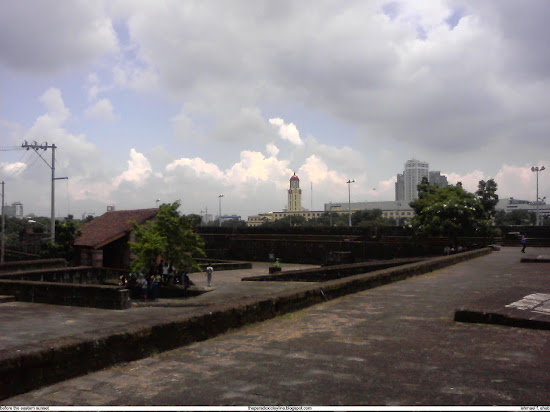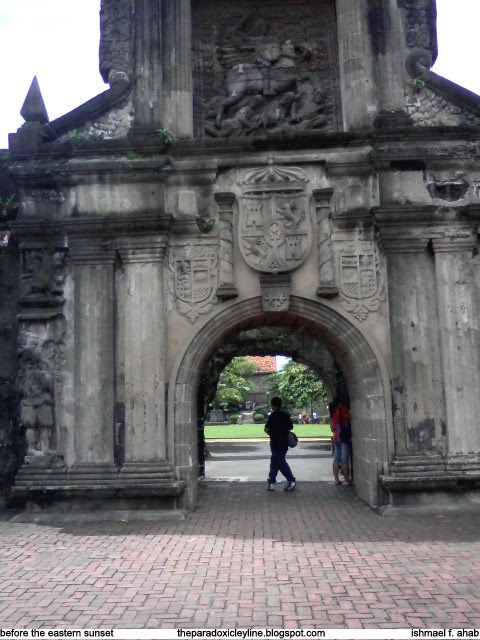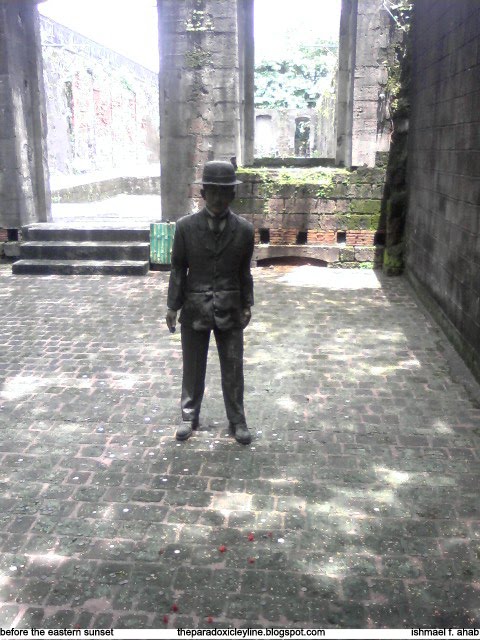.
At last I got the chance to visit the most historical site in Metro Manila. That site, of course, is Intramuros. It is located at the heart of Manila and stores the large part of Philippine history.
Intramuros is the center of the Spanish colonial government during the time when the Philippines is under the rule of the Spanish Empire. Intramuros is both a city and a fort and is protected by thick walls made of adobe and cannons that were used to repel foreign invaders and Filipino revolutionaries. Now, Intramuros serves as the country’s largest open-air museum showcasing different relics of the past.
I visited Intramuros during my birthday, accompanied by a friend. I thought that I will tour the whole Intramuros by foot. Thankfully, a pedicab driver / tour guide offered us a ride.
.
Touring Inside Intramuros
A visitor of Intramuros can visit the many points of interest by walking. However, this is not recommended for those who have a limited time to tour the place. Intramuros is a big place and walking will tire you out before you enjoy the sites and the relics within the whole city.
What I recommend is that you hire a pedicab driver (note: pedicab is a bicycle with a sidecar covered from sunlight and rain) to take you to the many places in Intramuros. The pedicab driver/tour guide knows the ins and outs of Intramuros. The one we hired, for instance, is armed with a pamphlet showing the historical places within the walled city. Thus, you could rely to the pedicab driver to tour you around the place if you are not sure where to go. The pedicab driver charges 100 pesos per hour. In the end of the tour I paid him 200 pesos for the two hours of service plus a tip of 50 pesos.
Aside for the pedicab, you could also hire a “kalesa” (a horse drawn carriage) to tour you around the city, but it is more expensive than hiring a pedicab. You may also opt for a formal tour offered by established tour companies and associations in Intramuros. The formal tour offers a ride on nice kalesa (probably a model of kalesa used by the affluent during the Spanish period) and a certified tour guide. However, it is the most expensive of all the touring options in Intramuros.
.
A foreigner enjoying her tour on a “kalesa”
.
Baluarte de San Andres
Our first stop is Baluarte de San Andres. It was built in 1903 to protect the Old Real Gate (the gate facing the Manila City Hall) and reinforce the Southeastern part of Intramuros. The Baluarte suffered two major destructions; the first is during the British siege of Manila (1762) and the Battle of Manila (1945). What I like most in this site is the set of cannons that were preserved since Spanish times. I couldn’t help but imagine a scene where our Katipuneros were being bombarded by these deadly cannons.
Here are some of my pictures of the cannons in this baluarte:
.
.
.
Puerta Real and Revellin de Real
These two places serve as a mini-museum of Intramuros. Puerta Real and Revellin de Real contain old bells, samurais and kabutos (armor of a Japanese warrior), ancient guns, small cannons and cannon balls. These ancient relics were unearthed within Intramuros. However, you could only look through the window to see these relics since entering the room holding these things is prohibited.
.
A room filled with cannons, guns, and helmets. The ball on the table on the lower left corner is a cannonball.
.
This is the largest of all the bells present in the room.
.
Here’s the few of the samurais unearthed within Intramuros.
San Agustin Church
The San Agustin Church is one of the churches that were built inside the walled city. Unfortunately, I did not get the chance to see the altar and the other things inside the church because it was locked. Because of this, I just contented myself at looking at the beautifully engraved doors of the church.
.
The locked doors of San Agustin Church.
.
Attempts to enter the church were thwarted by the threat of being eaten by the Church’s guards.
The Manila Cathedral was the place where the late President Cory Aquino was interned before she was sent to her final resting place. The cathedral serves as the office of the Archbishop of Manila. Located at the heart of Intramuros, the cathedral symbolizes the importance of the Church in the Philippine society.
.
The entrance to the Manila Cathedral.
.
Inside Manila Cathedral. The altar is too far be seen.
.
This is the best church door that I had ever seen.
.
The Church, the ship of salvation.
Our last stop is none other than Fort Santiago. The fort is the oldest fortification in Manila and dates back to the time of Rajah Soliman. Various places could be found inside Fort Santiago like Jose Rizal’s prison cell before he was sent to his execution in Bagumbayan (now known as Rizal Park), Rizal’s last footsteps, and the Dungeons. There is also a well-maintained park with food and souvenir shops. There is an entrance fee of seventy-five (75) Philippine pesos to enter the fort.
.
If you see this iron sculpture, then you know that you are in For Santiago.
.
This is the real entrance to Fort Santiago.
.
I didn’t know that I am much much taller than Jose Rizal.
Other Interesting Places in Intramuros
We also saw other places inside Intramuros. Here are some of them:
.
Gallery of Philippine Presidents.
.
Replica of General MacArthur and President Quezon.
.
Guns and cannons of Intramuros
.
Pamantasan ng Lungsod ng Maynila, which is under renovation.























